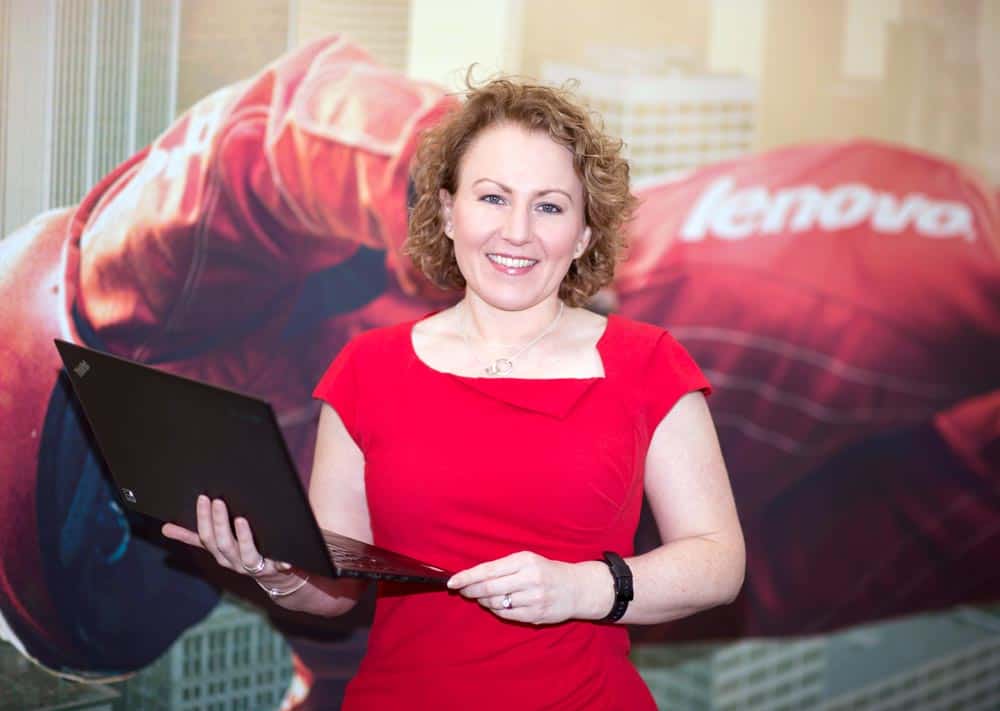Fiona O’Brien, EMEA Business Transformation Director at Lenovo, reflects on strategy and recruitment without borders at the PC company. By Deanna O’Connor.
There is much about Fiona O’Brien’s career that has been atypical. For starters, loyalty. She has essentially been with the same company (in its different forms) for most of her career. The company was the PC division of IBM, and she took on heading up Lenovo Ireland when China’s leading computer maker bought the division.
She went from the relative safety and security of working within a giant global company, to heading up operations in Ireland, learning all the regulatory necessities on the job and signing the papers to set up the business from a hospital bed as she struggled through a bout of pneumonia at that crucial time.
For O’Brien, taking over the running of the business in her late twenties, she suddenly had to operate at a different level than what she was used to within the relatively cosseted confines of a big multinational. “You really didn’t concern yourself with any of the detail,” she admits, “There are people to do those things in large multinationals, you have a very strong tax and accounting and regulatory function.”
“For me, it’s why my heart and soul always stays back with the Lenovo Ireland team because it was my baby. I had to learn how to create it and go and figure it all out and make it all happen within a very short period of time.”
That was 12 years ago, and after being thrown in at the deep end, all is going swimmingly for O’Brien – culminating with picking up Image magazine’s Digital, Science & Technology Businesswoman of the Year award last year.
O’Brien has lived at first-hand an experience almost like that of a startup, learning on the job how to run a company. Her role has grown internationally with Lenovo’s unique approach to talent and no specific EMEA headquarters. Although she retains the country-manager-for-Ireland responsibility, her role now encompasses business transformation across the wider group.
She still lives in Ireland, and travels extensively to keep up with the requirements of the job, meeting with a management team drawn from a number of different territories. she explains: “I work together with that team to constantly revise our strategies: how we’re going to market, how we’re addressing particular market segments and opportunities, what customer feedback we’re receiving that would require us to change.”
A COMPANY-WIDE STRATEGY
Lenovo’s strategy is interesting, not least because it brings to light differences in the workings and thought processes at Chinese companies – versus American influences that weigh heavily here in Ireland.
O’Brien explains: “What became very clear after maybe a year or so of operation was that we were a much smaller company than many of us were used to, having come out of the behemoth that is IBM, and we needed to work as a team together because there were so many cultural differences between the core Lenovo team back in China and the various countries around the world.”
While Lenovo was an enormously successful company in China, its purchase of IBM’s PC division was intended to give the company a global presence – and with that, it brought many different countries and nationalities into the group.
If we were going to be successful we needed a very clear and simple strategy that we could all align to
“If we were going to be successful we needed a very clear and simple strategy that we could all align to, that we all agreed with, and that we were committed to making happen,” O’Brien says. “Yang Yuanqing, who is our CEO and chairman, laid out a very clear, simple strategy, which we called ‘Protect and Attack’: protect what we had, which is our core relationship business, our good standing on the ThinkPad product; and attack the markets that, up until that point, we hadn’t been able to address.”
It’s a strategy that has worked across the board, as overall they reached their goal of number one status worldwide almost three years ago, and O’Brien puts this down to “long-term thinking” – which highlights the crucial difference filtering down from the Chinese leadership.
“The planning at a strategic level is much more in the long term than I had seen in my experience previously. The feeling is that you’re in for the long haul and there’s recognition that it takes time and focus to make something happen. So, they’re not going to flip from the total strategy,” she says.
TAKE TALENT WHERE YOU FIND IT
Another different approach that seems to be paying off is the decision not to have an EMEA headquarters. The company looks for talent wherever it finds it, matching the best person to a role regardless of geographic location.
“To be honest there is no real country bias anywhere in Lenovo,” reveals O’Brien. “It’s not how the company makes strategic decisions. There is a feeling that we don’t need to have a core group of people doing a particular function – they can be anywhere and everywhere; we will go to the market and get the best-in-class for that role, even if it means they have to work across country boundaries. It truly is multicultural in that sense. In our top 100 executives we have about 23 nationalities, so they really are spread everywhere and anywhere. You would be hard-pushed to find any country team that has done a lobbying job around investment in its country; because of its structure, it is really about the talent that we can tap into.”
IRELAND NOW
While Lenovo’s Irish arm has stayed more or less the same size since its inception, O’Brien is acutely aware of the challenges facing employers, particularly in the STEM space. “For Ireland itself, though, I think one of our big challenges is that we have always sold ourselves on our young, dynamic, highly skilled, educated workforce. But the reality is that many of us are finding it very difficult to find candidates.”
Traveling frequently, she has a bird’s-eye view of the environment and is wary that other countries are now passing us out in terms of the workforce as a draw. “I think we did a very good job for a long time in spotting that niche and being able to exploit it,” she admits, adding: “Now it’s becoming a lot more competitive. There are a lot more countries who have woken up to the requirement to invest, to drive individuals into the tech industry, into the type of skills that we need, and now we have to do something different. If we want to continue to be seen as a strong player we have to raise our game and we haven’t.”
You would be hard-pushed to find any country that has done a lobbying job around investment in its country
While education is a key factor in continuing to stay at the forefront, she also pinpoints making Ireland an attractive place for international staff as an important focus: “I think we need to be a lot more innovative in our course content, in the type of graduates that we are spitting out, and I also think there is a challenge on the sheer numbers that we have and unless we continue again to attract young people from around Europe to come in and work in Ireland, then we will max out on the number of people that we can make available through the employment market for large multinationals.”
THE PC WORLD
In her own industry, she remarks: “The PC market is under pressure; an overall consumerisation drive, the number of devices being bought is slowing down, and that’s on both PC and tablet, so you constantly have to redefine the segment, bring new product out that reinvigorates, that allows you to change the game – and that’s what we have to continue to do and that’s what our product development team are working on right now.” To this end, Lenovo has focused on ‘PC+’ – not just the PC market, delving into the Internet of Things (IoT) and connected devices.
The Smart Assistant was just launched at CES, the global consumer electronics and technology tradeshow, in San Francisco this January. It’s a voice-controlled smart speaker that can be used as a digital helper to do anything from turning on and off lights, to ordering toiletries online. Sounds alien now; we’ll all have one this time next year. O’Brien also hints at some “very slick” new products that are coming from the Motorola arm of the business.
While the IoT space continues to astound, amaze and filter technology into every aspect of our daily lives, O’Brien concludes by underlining the thinking that drives her forward: “I think from a company perspective our primary focus is to transform ourselves to be more customer-focused. We are at heart a product company, but we need to listen to the voice of our customer and be able to respond more easily to their unique requirements and that is probably the primary transformation driver that we have.”






